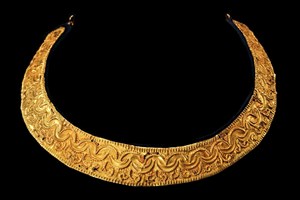
The Fowler Museum at UCLA, a renowned museum dedicated to global arts and cultures with an emphasis on Africa, Asia, the Pacific, and the Indigenous Americas, has announced the permanent and voluntary ethical return of royal objects to the Asante Kingdom in the Republic of Ghana.
The Fowler Museum, which recently celebrated its 60th anniversary, is a leader in repatriation to Native American tribal communities. This historic international return marks a significant milestone in the Fowler’s long history ofrestitution.
On February 5, 2024, Silvia Forni, the Shirley & Ralph Shapiro Director of the Fowler Museum; Erica P. Jones, Senior Curator of African Arts and Manager of Curatorial Affairs; and Rachel Raynor, Director of Registration and Collections Management, personally returned objects to His Majesty, Otumfuo Osei Tutu II, the 16th Asante King (Asantehene), on the 150th anniversary of the British looting of Kumasi, a city in the Asante Region of Ghana.
“We are globally shifting away from the idea of museums as unquestionable repositories of art, as collecting institutions entitled to own and interpret art based primarily on scholarly expertise, to the idea of museums as custodians, with ethical responsibility for the collection and towards the communities of origin of these collections,” said Forni.
To ensure the safe and ethical return of these objects, the Fowler Museum has worked closely with the Asante royal palace and Tufts University Professor and palace scholar Kwasi Ampene, who was integral in liaising the exchange.
Thanks to a 2019 grant from the Mellon Foundation, the Fowler was able to conduct extensive research into their colonial-era African collection. Among the objects in the collection were seven pieces that were either looted or extorted from the Asante in 1874 during the Sagrenti War (also known as the Third Anglo-Ashanti War). Before this research initiative, the Fowler’s database had no data linking these objects and the war. Once the Fowler confirmed their histories, they immediately sought to return the objects to the Asante. This process took years and required
the generous support of many people, including colleagues in the United States, Asante palace officials, and the Asantehene himself.
The returned objects include a sika mena (elephant tail whisk), two royal stool ornaments, a gorget (royal necklace) or stool ornament, bracelets and/or anklets, and an asipim (ornamental chair). According to the Fowler Museum’s research, four objects were taken on February 5, 1874, and three were part of the indemnity payment that was made after the Treaty of Fomena.
The pieces returned to Ghana on February 1, 2024, and arrived at the Asante palace on February 5, 2024, the 150th anniversary to the day of the Sagrenti War where the objects were taken by British Forces. A durbar and symposium will be held on February 8 to commemorate the anniversary.
The Fowler Museum has imposed no conditions on the returned objects. Whether they are installed in the museum, placed in the palace treasury, or used in public celebrations is entirely up to their stewards. They are museum pieces and also functional objects that could be used in a ceremonial setting. The Manhyia Palace Museum in Kumasi, for example, is a place where many objects have dual functions.
“At the Fowler Museum, we think of ourselves as temporary custodians of the objects in our collection,” said Jones. “In the case of pieces that were violently or coercively taken from their original owners or communities, it is our ethical responsibility to do what we can to return those objects. It is a process that will occupy generations of Fowler staff, but it is something that we are unwavering in our commitment to accomplish.”
This ethical return is one example of the Fowler Museum’s commitment to responsible steward- ship and the preservation and exploration of global arts and cultures.
Prior to their return, the objects were 3D-scanned, with permission from the Asante royal palace, and replicas have been commissioned by Ghanaian artists so that the Fowler can continue to display objects related to this history and tell the story of the Sagrenti War of 1874 in the Fowler’s galleries. This commission is also an opportunity to highlight the ways in which there is a direct continuity between then and now as there are still incredible gold workers employed by the palace and local individuals. The Fowler Museum is honored to include the contemporary replicas in their collections and exhibitions with credit to the contemporary artists.
Main Image :Work in gold, one of the objects returned to Ghana, was used as a gorget (royal necklace) or a stool ornament by the Asante kingdom.

ArtDependence Magazine is an international magazine covering all spheres of contemporary art, as well as modern and classical art.
ArtDependence features the latest art news, highlighting interviews with today’s most influential artists, galleries, curators, collectors, fair directors and individuals at the axis of the arts.
The magazine also covers series of articles and reviews on critical art events, new publications and other foremost happenings in the art world.
If you would like to submit events or editorial content to ArtDependence Magazine, please feel free to reach the magazine via the contact page.